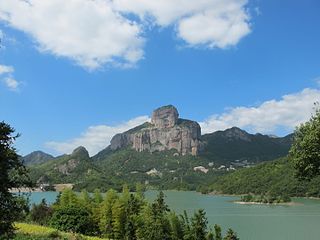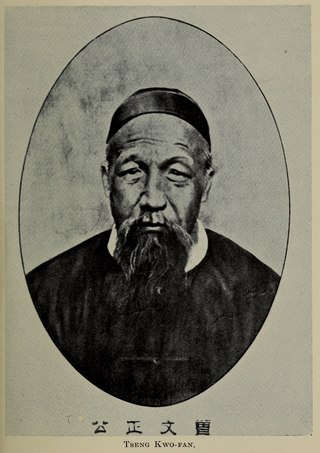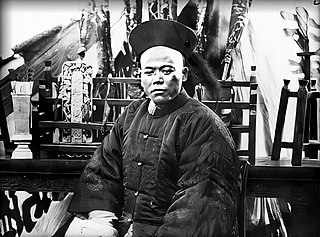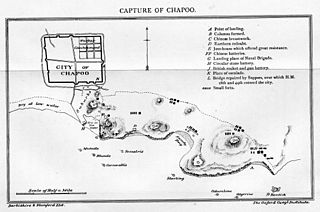
Zhejiang is an eastern coastal province of the People's Republic of China. Its capital and largest city is Hangzhou, and other notable cities include Ningbo and Wenzhou. Zhejiang is bordered by Jiangsu and Shanghai to the north, Anhui to the northwest, Jiangxi to the west and Fujian to the south. To the east is the East China Sea, beyond which lies the Ryukyu Islands. The population of Zhejiang stands at 64.6 million, the 8th largest in China. It has been called "the backbone of China" because it is a major driving force in the Chinese economy and being the birthplace of several notable people, including the Chinese Nationalist leader Chiang Kai-shek and entrepreneur Jack Ma. Zhejiang consists of 90 counties.

The Sibe or Xibo, are a Tungusic-speaking East Asian ethnic group living mostly in Xinjiang, Jilin and Shenyang in Liaoning. The Sibe form one of the 56 ethnic groups officially recognized by China, and had a recorded population of 190,481 in the 2010 Chinese Census, comprising just over 0.014% of China's total population.
The Eight Banners were administrative and military divisions under the Later Jin and Qing dynasties of China into which all Manchu households were placed. In war, the Eight Banners functioned as armies, but the banner system was also the basic organizational framework of all of Manchu society. Created in the early 17th century by Nurhaci, the banner armies played an instrumental role in his unification of the fragmented Jurchen people and in the Qing dynasty's conquest of the Ming dynasty.

Ningbo, formerly romanized as Ningpo, is a major sub-provincial city in northeast Zhejiang province, People's Republic of China. It comprises six urban districts, two satellite county-level cities, and two rural counties, including several islands in Hangzhou Bay and the East China Sea. Ningbo is the southern economic center of the Yangtze Delta megalopolis. The port of Ningbo–Zhoushan, spread across several locations, is the world's busiest port by cargo tonnage and world's third-busiest container port since 2010.

Zeng Guofan, Marquis Yiyong, birth name Zeng Zicheng, courtesy name Bohan (伯涵), was a Chinese statesman and military general of the late Qing dynasty. He is best known for raising and organizing the Xiang Army to aid the Qing military in suppressing the Taiping Rebellion and restoring the stability of the Qing Empire. Along with other prominent figures such as Zuo Zongtang and Li Hongzhang of his time, Zeng set the scene for the Tongzhi Restoration, an attempt to arrest the decline of the Qing dynasty. Zeng was known for his strategic perception, administrative skill and noble personality on Confucian practice, but also for his ruthlessness in repressing rebellions.
Hešeri, is a clan of Manchu nobility with Jianzhou Jurchens roots, originally hailing from the area which is now the modern Chinese provinces of Jilin and Liaoning. It was once one of the most important and powerful noble families in the early Qing dynasty in China, second only to the royal House of Aisin Gioro, to whom they were closely related by marriage.
The Jianzhou Jurchens were one of the three major groups of Jurchens as identified by the Ming dynasty. Although the geographic location of the Jianzhou Jurchens changed throughout history, during the 14th century they were located south of the Wild Jurchens and the Haixi Jurchens, and inhabited modern-day Liaoning and Jilin provinces in China. The Jianzhou Jurchens were known to possess an abundant supply of natural resources. They also possessed industrial secrets, particularly in processing ginseng and the dyeing of cloth. They were powerful due to their proximity to Ming trading towns such as Fushun, Kaiyuan, and Tieling in Liaodong, and to Manpojin camp near Korea.

The Yangtze Delta or Yangtze River Delta is a triangle-shaped megalopolis generally comprising the Wu Chinese-speaking areas of Shanghai, southern Jiangsu, northern Zhejiang and northern Jiangxi. The area lies in the heart of the Jiangnan region, where the Yangtze River drains into the East China Sea. Having fertile soil, the Yangtze Delta abundantly produces grain, cotton, hemp and tea. In 2021, the Yangtze Delta had a GDP of approximately US$4.3 trillion, about the same size as Japan.

Hangzhou Bay, or the Bay of Hangzhou, is a funnel-shaped inlet of the East China Sea, bordered by the province of Zhejiang and the municipality of Shanghai, which lies north of the Bay. The Bay extends from the East China Sea to its head at the city of Hangzhou, from which its name is derived.

Pamela Kyle Crossley is a historian of modern China, northern Asia, and global history and is the Charles and Elfriede Collis Professor of History, Dartmouth College. She is a founding appointment of the Dartmouth Society of Fellows.

Pinghu is a county-level city in the east of Jiaxing's administrative area, in the northeast of Zhejiang Province, bordering Shanghai to the northeast. It sits next to the East China Sea and the north shore of Hangzhou Bay. Prior to the Ming dynasty, Pinghu was part of Haiyan County. In 1430 Pinghu County was established. In 1991 Pinghu became a county-level city under the administration of the prefecture-level city of Jiaxing.
Mujangga was a Manchu statesman of the late Qing dynasty, belonging to the Gogiya (郭佳) clan. He belonged under the Bordered Blue Banner in the Eight Banners. In 1805, he was awarded the jinshi degree, the highest level in the imperial examination and quickly rose in the ranks of the Qing government. He became a member of the Grand Council in 1828 and gradually grew to exercise a decisive influence on the Daoguang Emperor's policies. Following the demise of Cao Zhenyong, Mujangga became the chief Grand Councillor in 1837. As tensions in Sino-British relations rose in 1839, he became one of the chief advocates of a conciliatory policy towards the British and following the outbreak of the First Opium War, he moved to dismiss Lin Zexu from his position as imperial commissioner in September 1840. Around 1845 he was President of the Hanlin Academy. Mujangga's conciliatory policies created tensions with the allegedly more xenophobic heir apparent, and following his accession to the throne as the Xianfeng Emperor, Mujangga was dismissed from all his positions in 1851.

Nanhu District is a district in Jiaxing, Zhejiang Province of China. Its former name was Xiucheng District (秀城区), and it changed to current name on 17 May 2005. Total area is 425.83 km2 (164.41 sq mi), and total population is 450,000 in 2001. At the end of 2013, the number of households registered in Nanhu District

Cheng Xueqi (Chinese: 程學啟; courtesy name Fangzhong 方忠; born in Tongcheng, Anhui, was a general of the Taiping Rebellion who surrendered to the Qing dynasty in 1861 with Ding Ruchang. He was an eminent Han Chinese official and a Captain General in the army of the late Qing dynasty. He led the Huai Army to fight effectively against the Taiping rebels and helped to restore the stability of Qing, along with other prominent figures, including Li Hongzhang and Zeng Guofan, setting the scene for the successful defense of Shanghai and the Suzhou Massacre POW Incident. The Tongzhi Emperor praised Cheng as "intelligent and brave".

Booi Aha is a Manchu word literally meaning "household person", referring to hereditarily servile people in the Eight Banner system in 17th-century Qing China. It is often directly translated as "bondservant", although sometimes also simply rendered as the common word, slave, or more specifically within Chinese social and political context as nucai.
Taihu Wu (吳語太湖片) or Northern Wu (北部吳語) is a Wu Chinese language spoken in much of the southern part of the province of Jiangsu, including Suzhou, Wuxi, Changzhou, the southern part of Nantong, Jingjiang and Danyang; the municipality of Shanghai; and the northern part of Zhejiang province, including Hangzhou, Shaoxing, Ningbo, Huzhou, and Jiaxing. A notable exception is the dialect of the town of Jinxiang, which is a linguistic exclave of Taihu Wu in Zhenan Min-speaking Cangnan county of Wenzhou prefecture in Zhejiang province. Speakers in regions around Taihu Lake and Hangzhou Bay, are the largest population among all Wu speakers. Taihu Wu dialects such as Shanghainese, Shaoxing and Ningbo are mutually intelligible even for L2 Taihu speakers.

The Battle of Chapu was fought between British and Qing forces at Chapu on the northern shore of Hangzhou Bay during the First Opium War.
Hangzhou Bay New Zone or Hangzhou Bay New Area is a development area in Cixi, Ningbo, Zhejiang province, China.

The Hangzhou Bay Ring Expressway, officially the Hangzhou Bay Region Ring Expressway and designated G92, is an expressway in China that connects the city of Shanghai to the cities of Hangzhou and Ningbo in the neighbouring province of Zhejiang. Part of its route traverses the Hangzhou Bay Bridge. It is 427 km (265 mi) in length.
The Peking Field Force was a modern-armed military unit that defended the Chinese imperial capital Beijing in the last decades of the Qing dynasty (1644–1912).















